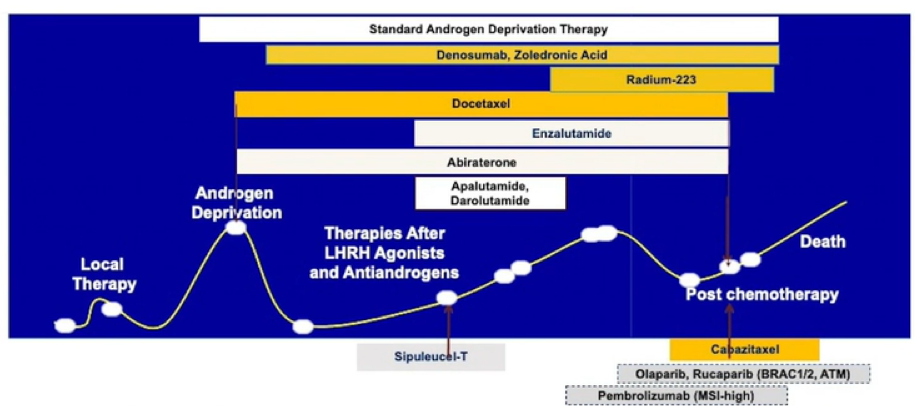(UroToday.com) Following Micheal Morris’s presentation of the results of the phase III VISION trial of lutetium-177-PSMA-617 in patients with metastatic castration-resistant prostate cancer in the Plenary Session of the 2021 American Society of Clinical Oncology (ASCO) Annual Meeting, Dr. Mary-Ellen Taplin from the Dana Farber Cancer Institute provided a discussant overview of these data and helped to contextualize how we may apply them to our practices.
Dr. Taplin began by providing an overview of the treatment landscape of prostate cancer in 2021, emphasizing that prostate cancer patients are fortunate to have many treatment options – with 10 approved agents with the potential to prolong life. However, unfortunately, the response to each agent when sequenced is often short.
Dr. Taplin then focused on the question of patient selection in the VISION trial. She emphasized that this trial relies on centrally read PSMA-PET imaging for inclusion. In addition to requiring at least one PSMA-positive metastatic lesion, patients could not have PSMA-negative metastatic lesions, defined as a bony lesion with a soft-tissue component of 1 cm or greater, lymph node 2.5 cm or greater, or solid organ 1.0 cm or greater. She emphasized that, among screened patients, 86.6% (869 of 1003) met these PSMA criteria while 12.6% didn’t meet the criteria. Given the wide prevalence in this screening population, Dr. Taplin hypothesized whether the trial would have been positive in a non-selected population and whether PSMA-based inclusion is required.
Further discussing the study population, Dr. Taplin pointed out that minorities are poorly represented in this cohort, despite the fact that prostate cancer is both more common and more lethal in black men.

Dr. Taplin then considered the methodologic considerations of the use of two alternate primary endpoints. This study design relied on relatively aggressive alpha splitting. In spite of this, she highlighted, as Dr. Morris had done, that VISION was strongly positive with a statistically significant improvement in overall survival of 4 months. While she described this as a “very positive” trial, she suggested that she was also somewhat disappointed in these results as she had hoped for even greater benefit. In considering this, she further considered a comparison with other trials in advanced post-chemo mCRPC. The median survival duration in the control arm in VISION is relatively comparable to other trials in this disease space (which ranges from 10.9 to 15.1 months). Similarly, the magnitude of treatment effect was similar, with a relative benefit between 30-40% and an absolute difference between 2.4 and 4 months.

Dr. Taplin further pointed out that there may be a small tail to the survival curve among patients receiving lutetium-177-PSMA-617 with 30% of patients alive at 18 months and 10% alive beyond two years. She further emphasized that there was relatively limited use of post-protocol treatments, emphasizing that this was truly a last line treatment option for many patients.
However, she emphasized that, while the effect of lutetium-177-PSMA-617 is relatively comparable to other treatment options in this disease space, it is mechanistically unique. This may offer the opportunity for both combination therapies and sequential utilization.
In terms of study conduct, Dr. Taplin emphasized the particular challenge of extremely high initial rates of drop-out among patients randomized to standard of care alone. This necessitated adjusting the analytic strategy, in discussion with the FDA. However, Dr. Taplin emphasized the importance of the study investigator’s responsibility to protect the integrity of the trial when they choose to participate. Thus, it behooves the investigator to appropriately educated participants about the trial design and equipoise, and to not enroll patients who can’t adhere to the study design.
Dr. Taplin then discussed the second primary endpoint, radiographic progression free survival. The VISION trial demonstrated a significant 5.3 month improvement in rPFS for patients who received lutetium-177-PSMA-617. Notably, another radiopharmaceutical with proven overall survival benefit, radium-223, did not show an improvement in rPFS. Dr. Taplin emphasized the psychological benefit of rPFS improvements for patients who are able to be reassured by seeing objective improvements in their disease.
She then moved on to discuss the toxicity associated with lutetium-177-PSMA-617 treatment. She noted that, in addition to fatigue, patients should be warned about the potential for manageable bone marrow suppression. These could be managed by transfusions, required in 13% of those receiving lutetium-177-PSMA-617 and 5% received standard of care alone. Further, there was evidence of an increased risk of second malignancies, though Dr. Taplin noted that most of these were skin cancers that she did not feel were attributable to lutetium-177-PSMA-617 treatment.
She did raise the question of whether treatment with lutetium-177-PSMA-617 would affect the future tolerance to chemotherapy or radiopharmaceuticals. However, 139 patients (25%) of the cohort received post-protocol chemotherapy and 16 (2.9%) received post-protocol radiopharmaceuticals, suggesting that these treatments are not precluded.
Moving forward, Dr. Taplin emphasized that theranostic treatment with radiopharmaceuticals is relatively routinely used in both Germany and Australia. As we consider treatment roll-out in the United States, she anticipates access issues as centers build capacity for radiopharmaceuticals. However, she anticipates high interest from patients who are already heavily treated. Further, she considered was in which the efficacy of lutetium-177-PSMA-617 may be improved. First among potential approaches, she emphasized that more doses may be feasible than the 6 allowed (and 4 mandated) on VISION. Further, combination approaches of lutetium-177-PSMA-617 with other approved prostate cancer treatments, the use in earlier stages of the disease, and other radiopharmaceutical compounds are likely to continue to change this disease space.
Thus, in concluding, she emphasized that the VISION trial met both of its primary endpoints and showed that lutetium-177-PSMA-617 + SOC significantly improved overall and radiographic progression-free survival, as well as many other secondary endpoints.
Presented by: Mary-Ellen Taplin, MD, Medical Oncologist, Dana-Farber Cancer Institute


